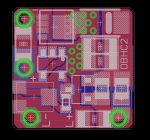rhd
0
- Joined
- Dec 7, 2010
- Messages
- 8,475
- Points
- 0
OSH stencils is fast. I think they cut them in the USA.
Okay, now that we have RC1 behind us, and there's a working, clean output, inexpensive 2.4A boost. It's worth discussing objectives for the future.
I would propose as a worthy next goal, the ability to reliably output a clean 4A at 5V, from a single lithium ion, without substantially increasing the size of the driver, and keeping the part costs under $10.
That's not an easy target.
Okay, now that we have RC1 behind us, and there's a working, clean output, inexpensive 2.4A boost. It's worth discussing objectives for the future.
I would propose as a worthy next goal, the ability to reliably output a clean 4A at 5V, from a single lithium ion, without substantially increasing the size of the driver, and keeping the part costs under $10.
That's not an easy target.







